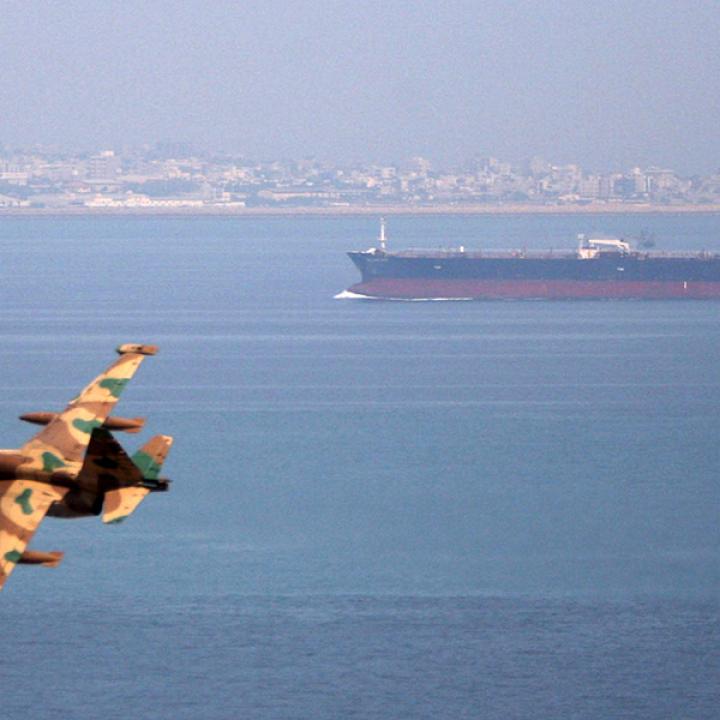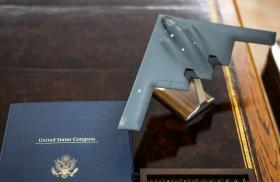
- Policy Analysis
- PolicyWatch 4058
How the Iran-Israel Conflict Is Affecting Gulf Energy and Maritime Security

For regional countries seeking to transform their economies and partner with the United States in areas including AI, the current war poses risks that could reverberate in the global economy.
A key question amid the fighting between Iran and Israel—now aided by the United States—is whether the conflict will prompt a disruption of exports traveling from the Persian Gulf through the Strait of Hormuz. Some 35 percent of global seaborne crude oil and 20 percent of liquefied natural gas (LNG) move through this chokepoint, which is vital for major market players including Saudi Arabia, the United Arab Emirates, Iraq, and Qatar—as well as Iran itself.
Thus far, commercial traffic is still moving, although some vessels have changed course. Furthermore, Iran’s June 23 retaliation for the U.S. strike on its nuclear facilities targeted al-Udeid Air Base in Qatar, a move interpreted as low-risk for energy flows, thus leading oil prices to drop sharply. But the risk to energy and maritime interests will remain high if the conflict widens. Moreover, while global attention has understandably focused on energy flows from the Persian Gulf, the larger question remains of how persistent regional conflict could jeopardize energy security and economic prosperity, and the ways such dynamics might affect global markets. President Trump’s May visit to the Gulf, which facilitated the signing of several energy and technology deals, set these opportunities in relief.
Tech and Energy Partnerships Require Stability
The condemnation of Israel’s attacks against Iran by Saudi Arabia and the UAE came as no surprise. Since Hamas’s October 2023 massacre sparked war across the region, the two Gulf states have labored to shield themselves from ramifications that clash directly with their visions for the economy, energy, and technology. Even in the Red Sea, where the Houthis have caused severe disruptions to global trade, Riyadh and Abu Dhabi have opted to remain on the periphery. But they cannot ignore the current air exchanges over the Gulf, and they recognize that a prolonged war, or regime change in Iran, could have spillover effects at home.
On June 17, when Iran and Israel were trading deadly strikes but the United States had not yet entered the conflict, the Emirati minister of industry and advanced technology, Sultan Ahmed al-Jaber, underlined his country’s support for “peace over provocation...and progress through partnership, and only partnership.” Jaber, who was speaking in Washington DC at the Global Energy Forum organized by the Atlantic Council, dedicated most of his speech to the intertwinement of the artificial intelligence and energy sectors, a relationship much remarked-upon in U.S.-UAE discussions.
Generally, the United States is looking to strengthen its AI leadership through global partnerships. And both the UAE and Saudi Arabia, seeking to transform their economies, aspire to be AI hubs and partners in the American effort. Just last month, Washington and Abu Dhabi agreed on a “U.S.-UAE AI Acceleration Partnership” framework to expand cooperation on critical technologies. For like-minded Riyadh, one prominent project has paired the Saudi wealth fund (known as the Public Investment Fund) with Google Cloud to build an AI center near Dammam, in eastern Saudi Arabia along the Persian Gulf coast.
These AI projects all require massive amounts of power, necessitating an expansion and optimization of the existing energy infrastructure—efforts on which Saudi Arabia and the UAE have been focused. Both countries are major fossil fuel producers, and they continue to expand oil and gas investments through innovative digital technologies. At the same time, they are reshaping their energy landscape to gradually increase the share of low-carbon and clean technologies such as solar, wind, and nuclear. During President Trump’s visit in May, both countries signed agreements with leading U.S. firms related to oil production expansion, LNG collaboration, and AI solutions in the energy sector, among other areas.
Yet the success of these partnerships requires stability, especially in the Persian Gulf. This is all the truer given existing stresses on other regional waterways, like the Red Sea, that are critical for trade, energy, and global connectivity.
Energy and Maritime Security Are Interconnected
Should the volatile regional situation worsen further, the Gulf states will have to weather a set of challenges as they transform their economies. Thus far, both Iran and Israel have limited their attacks on each other’s energy assets, appearing to focus mainly on sites linked to domestic consumption rather than vital production and export infrastructure. Among Israel’s targets were a South Pars (Phase 14) gas processing unit, a fuel depot, and storage tanks at a refinery, while Iranian missiles hit Israel’s Haifa refinery, causing it to shut down.
The U.S. bombings carried out June 21 against Iran’s nuclear infrastructure, including the Fordow enrichment facility, may still prompt retaliation that includes individual maritime attacks, a prospect that would deepen concerns in the energy and shipping markets about logistical disruptions and other risks. In recent years, Iran retaliated against U.S. and even Israeli actions it deemed provocative by targeting commercial vessels, such as on April 13, 2024, when the Islamic Revolutionary Guard Corps Navy, in a helicopter raid, seized the Portugal-flagged MSC Aries (IMO 9857169) container ship as it sailed in the Gulf of Oman near the Strait of Hormuz. At its capture, the vessel was chartered from Gortal Shipping, an affiliate of the Israeli magnate Eyal Ofer’s Zodiac Maritime, according to TradeWinds (also see The Washington Institute’s maritime incident tracker).
If it seeks further escalation, Iran may repeat similar attacks against U.S.-linked vessels, while allowing other commercial ships to sail normally. Moreover, even a verbal threat from Tehran may be sufficient to force some vulnerable vessels to pause their transit into the Persian Gulf— although this could lead to tensions between the Islamic Republic and Gulf states.
Yemen’s Houthis, who have shown themselves to be notably risk-acceptant in recent campaigns, may also decide to expand their maritime attacks in support of Iran. Just before the U.S. strikes on June 21, they threatened to resume targeting American ships should an attack happen. In the current high-risk environment, the Houthis may track and target commercial vessels the group deems linked to the United States or Israel in waterways including the Arabian Sea. Reflecting an awareness of persistent Houthi control over the Bab al-Mandab Strait, some commercial ships in the Red Sea and Gulf of Aden continue to signal ownership and nationality of crew as well as cargo origin through their automatic identification system. Vessels engaging in this behavior include those linked to China and Russia, whose signaling is intended as a message to the Houthis not to attack. A similar trend could emerge in the Persian Gulf amid concerns that Iran’s retaliation might include the maritime arena. Further, depending on how the conflict evolves, the Houthis may resume their threats to attack infrastructure in Saudi Arabia, and any successful attack on energy facilities would increase oil volatility.
Hormuz Closure Would Unsettle Region, Markets
Finally, the prospect that Iran could close the Strait of Hormuz must not be ignored given the problems it could create, even as Tehran has previously wielded this threat several times without acting on it. Saudi Arabia, the UAE, and other Gulf oil and gas exporters rely heavily on this chokepoint, and even a brief shutdown would rattle their economies as well as global markets. Iran itself depends on Hormuz to export oil, continuing to do so during the current conflict, with exports remaining strong. According to the market intelligence firm Kpler, last week Iran loaded around 2.2 million barrels per day of crude oil.
Iran will only likely close the Strait if it can no longer export oil as a consequence of damage to its critical output or export infrastructure. Moreover, any individual maritime incident in the Persian Gulf would be enough to keep the global oil market jittery and the whole region unstable.
Noam Raydan is a senior fellow at The Washington Institute and co-creator of its Maritime Spotlight series and maritime incident tracker.



